Welcome to our blog on Free-range chicken farm operations management with month-wise maintenance for better profits. You’ve come to the right place if you’re a free-range chicken farmer looking to optimize your operations and boost profitability. Managing a free-range chicken farm involves various tasks and considerations throughout the year.
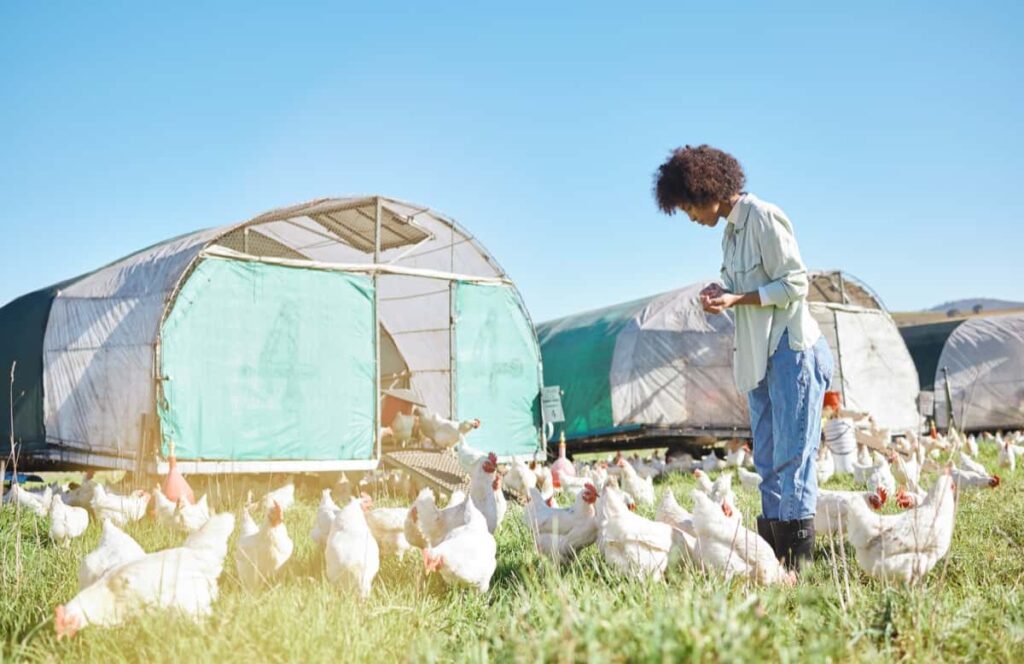
This blog series will guide you through a month-by-month maintenance schedule covering essential activities, from infrastructure maintenance and health monitoring to marketing strategies and financial reviews. By implementing these practices, you can enhance your farm’s efficiency, ensure the well-being of your flock, and ultimately increase your profits.
What is Free Range Chicken Farm?
Free-range chicken farming is a husbandry method where chickens can roam freely outdoors rather than being confined to indoor enclosures all day. Although the outdoor area is often fenced, it still allows for extensive movement and exposure to sunlight, which are restricted in indoor housing systems. This method can be applied to producing meat, eggs, or dairy.
The term “free range” has two different meanings: one from the perspective of farmers describing their husbandry methods and another from consumers seeking products from such methods. Some individuals follow an ethical omnivorous diet, meaning they only consume free-range meat. Unlike intensive animal farming practices like concentrated animal feeding operations, free-range livestock can roam without being fenced in.
Importance of Free-Range Chicken Farm Operations Management
- Animal Welfare: Free-range systems allow chickens to engage in natural behaviors, promoting their physical and psychological well-being.
- Healthier Products: Free-range chickens have access to a varied diet, including grass, insects, and natural forage, resulting in meat and eggs with higher nutritional value and improved flavor.
- Environmental Sustainability: Proper management of free-range operations promotes sustainable land use, reduces environmental impacts, and preserves biodiversity.
- Consumer Demand: There is a growing market demand for ethically-produced, high-quality free-range chicken products, making effective operations management crucial for meeting consumer expectations.
- Profitability: Efficient management practices optimize production, minimize costs, and enhance overall farm profitability.
- Reputation and Branding: Well-managed free-range operations build a positive reputation and brand image, attracting loyal customers and potentially commanding premium prices.
- Compliance with Regulations: Implementing effective operations management ensures adherence to animal welfare standards and governmental regulations, avoiding legal issues and penalties.
- Community Relations: Demonstrating responsible and sustainable farming practices through effective operations management fosters positive relationships with local communities, supporting long-term success.
In case you missed it: Country/Free Range Chicken Farming Project Report: Business Plan, Investment, Profit, and Loan in India

How to Start Free-Range Chicken Farm
- Select Suitable Chicken Breeds: Choose chicken breeds that are well-suited for free-range farming, such as Rhode Island Red, Kuroiler, or Noiler. These breeds are known to perform well in a free-range environment.
- Create a Conducive Environment: Provide a comfortable resting area for the chickens, and consider incorporating trees into the farm to mimic their natural habitat. Trees offer shade, protection from harsh weather conditions, and areas for the chickens to engage in natural behaviors like foraging and dust bathing.
- Ensure Access to Freshwater and Diet: Provide clean and fresh water for the chickens. In a free-range system, chickens have the opportunity to select their feed. Consider incorporating greens, herbs, and pasture into their diet, and explore options like fodder as a nutritious and cost-effective feed source.
- Protect from Predators: Implement adequate security measures to protect the chickens from predators. Ensure that the free-range area is well-fenced and secured to prevent access by snakes and other harmful animals.
- Allow Expression of Innate Behaviors: Free-range systems allow chickens to express their natural behaviors, contributing to their overall health and well-being. This includes behaviors like foraging, scratching, and roaming freely. Providing the opportunity for chickens to engage in these behaviors enhances their growth and productivity.
Advantages of Free-Range Chicken Farming
- Healthier and better-growing chickens compared to other systems.
- More nutritious and flavorful products (meat and eggs).
- Reduced spread of diseases compared to other systems.
- Decreased feeding and housing costs.
- Easy and less time-consuming management.
- Enhanced study of chickens in their natural environment.
- Cushioning the effects of extreme weather conditions.
- The sustainable farming system allows chickens to reach their genetic potential.
- Production of high-quality products despite lower quantities.
General Activities, Operations, and Maintenance on a Free-Range Chicken Farm
- Daily Feeding and Watering: Ensure the chickens have access to water and a balanced diet. Monitor their feed consumption and adjust the feeding regimen as needed.
- Pasture Management: Implement rotational grazing practices to optimize the use of available pasture. This helps prevent overgrazing, maintain forage quality, and control the spread of parasites.
- Coop Cleaning and Maintenance: Regularly clean the chicken coops to maintain hygiene and prevent the buildup of waste and pathogens. Repair any damaged structures or fencing to ensure the safety and security of the chickens.
- Nest Box Management: Regularly collect eggs from the nest boxes to prevent them from becoming dirty or broken. Provide clean bedding material and ensure the nest boxes are comfortable for the hens.
- Health Monitoring and Disease Prevention: Observe the flock for signs of illness or distress. Implement a vaccination and deworming schedule to prevent common diseases and parasites.
- Predator Control: Take measures to protect the chickens from predators such as snakes, foxes, or birds of prey. Secure the free-range area with proper fencing and implement deterrents to minimize predation risk.
- Egg Collection and Processing: Collect eggs regularly to maintain their freshness. Clean and store them properly, following food safety guidelines. If selling eggs, consider grading, packaging, and labeling them appropriately.
- Record Keeping: Maintain accurate records of flock health, production data, feed consumption, and other important metrics. This information helps evaluate performance, identify trends, and make informed decisions.
- Marketing and Sales: Develop marketing strategies to promote your free-range products. Identify target markets and explore sales channels such as local farmers’ markets, grocery stores, or direct-to-consumer sales.
In case you missed it: Sustainable Poultry Farming: Benefits and How to Reduce Your Carbon Footprint with Chickens
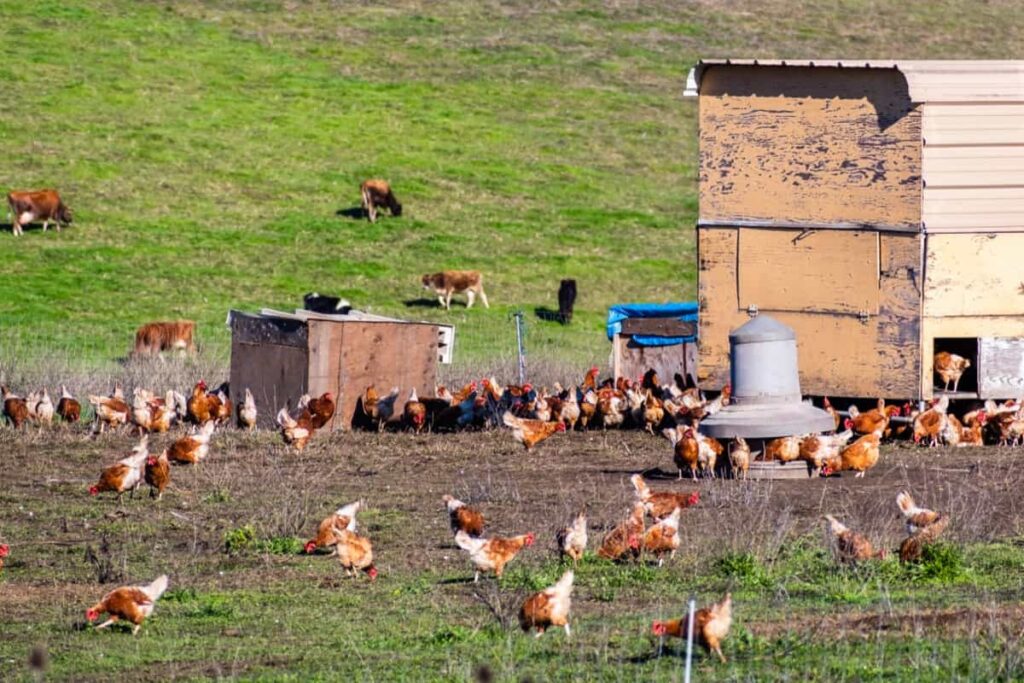
Operations Management of Free-Range Poultry
Housing Requirements
- Space: The available space determines the number and type of poultry that can be kept. A density of three to four birds per square meter is comfortable for hen groups.
- Ventilation: Proper airflow is crucial in poultry housing. Cross-ventilation at bird level should be allowed, and buildings relying on natural airflow should not exceed 8 meters wide.
- Light: Well-lit houses are essential for poultry. Light is important for feeding and influences sexual maturity and egg production.
- Protection: Housing should protect poultry from weather conditions and predators. Factors like local climate, available space, flock size, and management system influence housing choice.
Space Requirements
- The recommended floor space per bird varies depending on the type of chicken. For layers, it is three birds per square meter, while for dual-purpose and meat chickens, it ranges from 4-5 birds per square meter.
- Perch space is also important, with recommended lengths ranging from 15-25 cm per bird, depending on the chicken type.
Ventilation
- Ventilation is crucial in poultry housing. Natural airflow or cross-ventilation at bird level is ideal, and wider buildings may face challenges with air movement.
- Heat stress can be a constraint, and temperatures above 40°C can harm chickens. Proper ventilation and orientation of the building can help minimize heat stress.
Protection from Predators
- Poultry housing should protect birds from predators such as hawks, rats, snakes, dogs, cats, foxes, and raccoons.
- Measures like using strings or fishing nets to deter predator birds, setting leg traps for large predators, and plugging holes can help prevent attacks.
- Control methods vary depending on the predator, such as hunting, rat poison, or fishhooks.
Housing in Free-Range Systems
- Free-range systems require overnight shelters that are roomy, clean, and airy. Fixed or mobile chicken houses can be used.
- Stocking density should be calculated based on soil type and pasture management. The floor should be raised in regions with heavy rainfall.
- Walls can be mud or bamboo, and feeders should be bird-proof and adjustable in height.
In case you missed it: Chicken Farming in Indonesia: Poultry Business Plan, Setup Cost, License, Profit, and Requirements
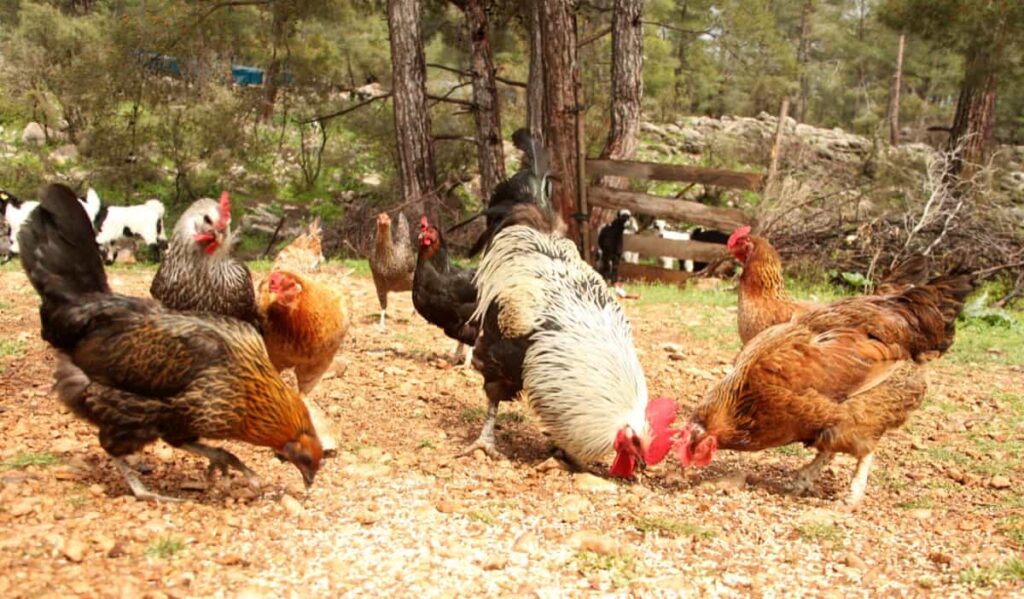
Feeder Requirements
- Feeders should be durable, stable, of the correct height and depth, bird-proof, and equipped with a lip to prevent feed wastage.
- Feeder space should provide enough access for birds, with recommended measurements depending on the age of the chickens.
- The supplementary vegetable matter should be fed at beak level, either hung from the ceiling or placed in a net or floor-standing hopper.
Creep Feeders
- Creep feeders are used to provide baby chicks with access to high-quality feed. They have small doorways that allow chicks to “creep” through.
- Creep feeders help ensure that chicks receive nutrition for optimal growth and development.
Controlling Poultry Movements
- Unrestricted free-ranging poultry can cause problems by trespassing onto neighboring fields and gardens and being exposed to predators.
- Fencing vegetable plots can be an effective solution to limit their movements.
- Increasing the number of cocks in the village may help confine chickens to their territories.
Balancing Scavenging and Supplementary Feed
- The difference between scavenged feed and total food requirements in a free-range system should be balanced with supplementary feed.
- A balanced supplement should include protein concentrate, a carbohydrate source for energy, and a mineral source, especially for calcium carbonate required for eggshell formation.
- Poultry should have access to this supplement for a few hours in the evening to supplement their scavenging.
Economic Viability of Supplementary Feed
- The consumption of supplementary feed per egg produced should be around 150 to 180 g or less for economic viability.
- Supplements are typically recommended for 50 to 80 g per bird per day.
- Seasonal variations in scavenged feed availability should be considered, and adjustments should be made to maintain optimal production levels.
Productivity Enhancement
- Changes in husbandry practices alone can increase the productivity of scavenging village chickens without additional inputs.
- Stocking rates of 120 to 180 birds per hectare in planted orchards can help clean up windfalls and fertilize trees.
Fertilizer Production from Manure
- The manure produced by hens has fertilizer value.
- A flock of 150 hens can produce approximately 49.5 kg of dried manure per year, equivalent to fertilizers like ammonium nitrate, super-phosphate, and potash salts.
In case you missed it: Ayam Cemani Chicken Breed Guide: Characteristics, Cost, Egg Laying, Care,
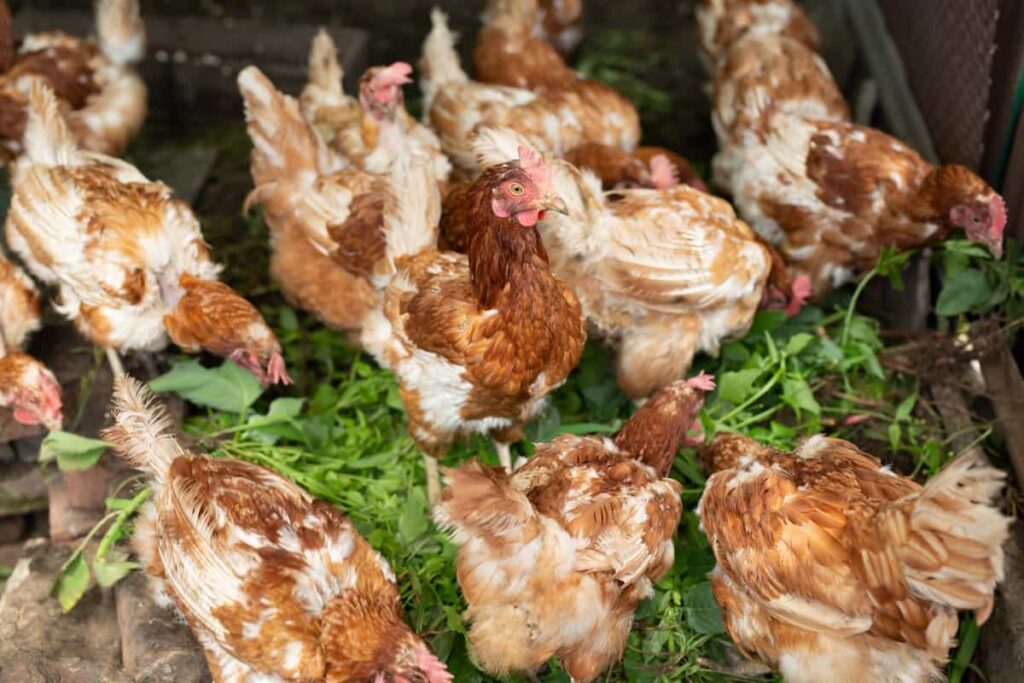
Planning Flock Production and Size
- Flock size fluctuates due to hatchings, sales, and mortality.
- Mortality, especially during the rainy season and periods of weather changes, is a significant cause of flock depletion.
- Maintaining a regular flock size requires setting aside eight to ten eggs for reproduction per layer.
Income Generation
- Village flocks’ income primarily comes from selling eggs and live birds.
- Culling unproductive birds is important, and productive birds should be selected for breeding.
Month-Wise Management in Country Farms or Free-Range Chicken Farms
January: During January, free-range chicken farms focus on providing shelter and adequate heating for the chickens to protect them from harsh winter conditions. The farm staff regularly inspects the coops to ensure they are well-maintained and secure. Additionally, the chickens are provided with a balanced diet rich in nutrients to support their growth and health.
February: In February, free-range chicken farms start preparing for the upcoming breeding season. The farm staff monitors the chickens’ reproductive cycles and ensures proper mating conditions. They also implement biosecurity measures to prevent the spread of diseases and maintain a healthy breeding environment.
March: As spring arrives, free-range chicken farms emphasize pasture management. The farm staff rotates the chickens across different grazing areas, allowing the vegetation to regenerate naturally. This practice helps maintain soil fertility and provides the chickens fresh forage, promoting their overall well-being.
April: During April, free-range chicken farms intensify pest control measures. The farm staff regularly inspects the coops and surrounding areas for signs of pests and takes necessary actions to prevent infestations. They may use environmentally friendly methods or natural predators to manage pests, ensuring the chickens’ safety and health.
May: May is an important month for flock health management in free-range chicken farms. The farm staff conducts regular health checks on the chickens, monitoring for signs of illness or disease. They administer vaccinations and implement preventive measures to minimize the risk of outbreaks, ensuring the overall well-being of the flock.
June: In June, free-range chicken farms focus on maximizing egg production. The farm staff ensures the chickens have access to high-quality nesting areas and a balanced calcium-rich diet. They also monitor egg quality and collect them regularly. Proper egg handling and storage practices are followed to maintain freshness and minimize waste.
July: During July, free-range chicken farms prioritize predator control. The farm staff reinforces coop security measures and uses deterrents to protect the chickens from predators such as foxes or raccoons. Regular patrols are conducted, especially during nighttime, to ensure the flock’s safety.
August: August marks the time for pasture renovation in free-range chicken farms. The farm staff prepares the grazing areas by reseeding and fertilizing the pasture to promote healthy vegetation growth. This ensures a sustainable and nutritious foraging environment for the chickens.
September: In September, free-range chicken farms begin preparing for the upcoming colder months. The farm staff insulates the coops and implements additional heating measures to keep the chickens warm during the upcoming winter. They also adjust the chickens’ diet to give them extra nutrients for better cold tolerance.
October: During October, free-range chicken farms emphasize biosecurity protocols. The farm staff restricts visitor access, implements strict hygiene practices, and monitors the flock for any signs of illness. These measures help prevent the introduction and spread of diseases, safeguarding the health and well-being of the chickens.
In case you missed it: Understanding Backyard Poultry/Chicken Farming at Home: Check How this Guide Helps Beginners
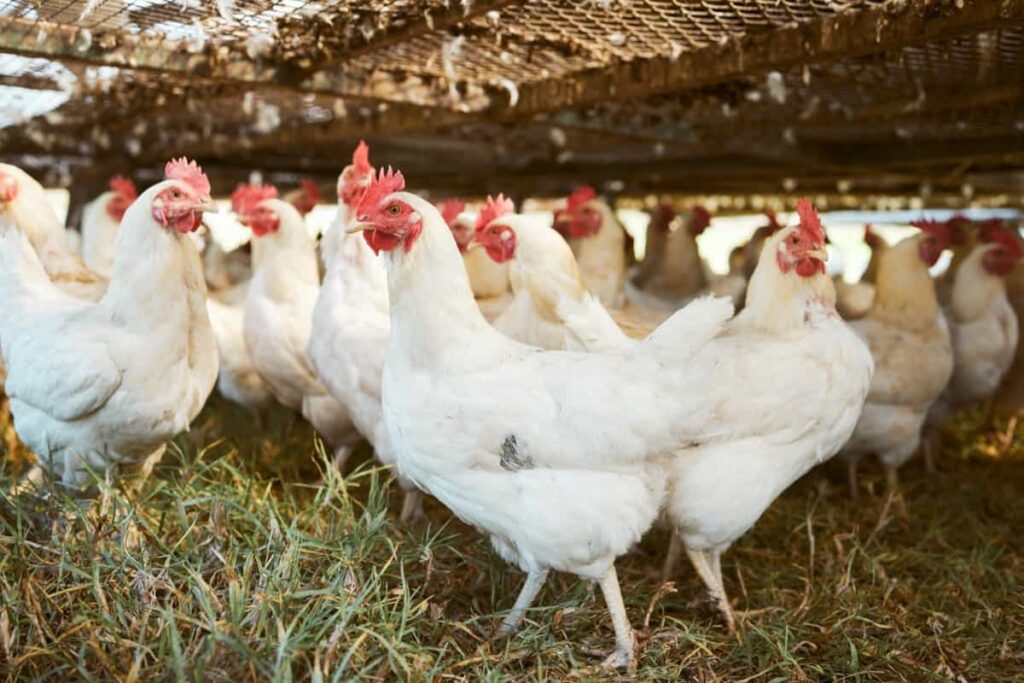
November: In November, free-range chicken farms focus on marketing and sales. The farm staff promotes their products through various channels, such as farmers’ markets or online platforms. They ensure proper packaging and labeling, highlighting the farm’s commitment to quality and sustainable practices.
December: December brings festive preparations in free-range chicken farms. The farm staff enhances the chickens’ environment with seasonal decorations, ensuring their well-being and a pleasant atmosphere. Additionally, they plan for the upcoming year, reviewing the farm’s performance and setting goals for improvement and growth.
Conclusion
Efficient month-wise management in free-range chicken farms is crucial for maximizing profits. By focusing on activities such as shelter maintenance, breeding preparations, pasture management, health checks, predator control, and marketing strategies, farms can ensure the flock’s well-being and optimize production, leading to better financial outcomes.
- How to Raise Pigs in Your Own Backyard: A Comprehensive Guide
- Budget Friendly Sheep Shed Ideas: Cheap and Low-Cost Tips
- How Much Do Cattle Farmers Make: Revenue Streams in Cattle Farming
- Management Pests and Diseases in Your Cotton Field
- Sheep Farming Business Plan for Beginners
- Aquaponic Farming at Home: A Step-By-Step Guide
- Profitable Village Farming Business Ideas in 2024
- High-Yield Aquaculture: Fast-Growing Fish for Farming
- Effective Fish Pond Construction Techniques for Beginners
- Irrigation and Water Management in Pineapple Farming
- Blossom to Harvest: Mastering Flowering and Pollination in Papaya Farming
- Pig Fattening Essentials: From Selection to Sale for Beginners
- Raising Wagyu Cattle: A Complete Guide for Premium Beef Production
- Soil Types and Their Water Holding Capacity
- Optimizing Irrigation Schedules for Coconut Groves for Enhanced Yield
- Espresso Your Garden: Coffee Grounds for Healthier Acid-Loving Plants
- The Best Soil Mix for Snake Plants: How to Mix Your Own Snake Plant Soil
- Green Thumb Success: Expert Tips for Cultivating Greenhouse Beans All Year Round
- Bloom All Year Round: The Ultimate Guide to Indoor Hyacinth Care
- Eco-Friendly Gardening: How to Make Liquid Fertilizer from Kitchen Waste
- Ultimate Guide to Grow Anise in Pots: Explore Seed Propagation to Harvesting
- Guide to Raising Chester White Pigs: Discover Breed Facts to Growth Management
- Mastering the Elegance: The Ultimate Guide to Weeping Cherry Tree Care, Planting, and Maintenance
- Ultimate Guide to Planting Garlic in Grow Bags: Growing Strategies for Beginners
- How to Fix Spider Plant Leaf-Related Problems: Natural and Organic Remedies
- 10 Reasons Why Your Tulsi Plant is Shedding Leaves: Home Remedies and Solutions
- Optimizing Growth and Yield: The Advantages of Palm Bunch Ash Fertilizer
- Utilizing Neem Oil Extract as a Natural Pesticide for Hydrangea
- From Soil to Harvest: Various Ways in Which Farmers Can Use AI Tools
- Steps to Encourage and Induce Citrus Flowers: A Comprehensive Guide
- How to Fix Snake Plant Leaf-Related Issues: Natural and Organic Remedies
- Transform Your Garden into a Fragrant Oasis with Raat Ki Rani (Night Blooming Jasmine)
- Discover the Ideal Chicken Breeds for Philippine Farms
- How to Create a Poultry Egg Farm Business Plan for Profits
- Grow Lemon Cucumbers Like a Pro: Insider Techniques for Bountiful Yields
- Ultimate Guide to Caring for Your Pink Princess Philodendron: Tips for Thriving Variegation
